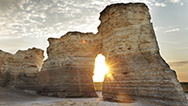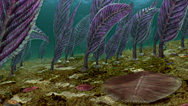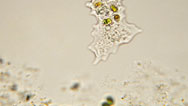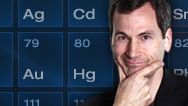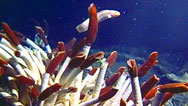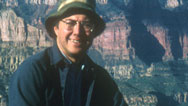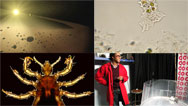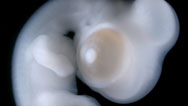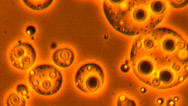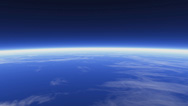
Life's Rocky Start
What is the secret link between rocks and minerals, and every living thing on Earth? Airing May 9, 2018 at 10 pm on PBS Airing May 9, 2018 at 10 pm on PBS

Program Description
Transcript
Life's Rocky Start
PBS Airdate: January 13, 2016
NARRATOR: They are dazzling, priceless, at times even glowing…
ROBERT HAZEN (Carnegie Institution for Science): How can one not fall in love with rocks and minerals? I mean the colors, the shapes.
NARRATOR: …and they're the building blocks of modern civilization.
ROBERT HAZEN: We wouldn't have televisions, we wouldn't have automobiles, we wouldn't have buildings, without the mineral riches that we have.
NARRATOR: But could rocks and minerals also solve the greatest mystery of all time: the origin of life?
ROBERT HAZEN: The rocks we pick up tell a story: that life couldn't have occurred without rocks.
NARRATOR: Could cold, lifeless stone hold the key to every living thing on Earth? From Australia to Morocco, NOVA goes around the world and back in time to investigate the origin and evolution of life…
RUTH BLAKE (Yale University): You look at a rock, you think, "Ah, well, nothing." But this holds the signature of life.
NARRATOR: …from its first spark…
JEFFREY BADA (Scripps Institution of Oceanography): People were saying they made Frankenstein in a test tube.
NARRATOR: …to the survival of the fittest.
ROBERT HAZEN: These were immense creatures, sharks that may have been 50 or 60 feet.
NARRATOR: Was it the secret link between rocks and life that made the difference? Life's Rocky Start, right now, on NOVA.
The ancient market of Marrakech, a chaotic, colorful gathering place, teeming with life for thousands of years: the perfect place to ask, "How did this exotic, beautiful and sometimes bizarre thing called life begin?" How did Earth go from a lifeless, molten rock to a living planet, full of diverse and spectacular creatures?
It's a question that has long perplexed scientists. Now, Robert Hazen, a geologist, is trying to show we are missing an essential ingredient in the recipe for life: rocks.
Nothing seems more lifeless than a rock. It's inanimate. It's the antithesis of a living thing. But we are beginning to realize that rocks played an absolutely fundamental role in the origin of life.
NARRATOR: Hazen is out to expose a secret relationship between rocks and life that helped drive both the origin of life and its evolution into complex creatures.
ROBERT HAZEN: This is a very new set of understandings, and the more we look, the more we see that life depends on rocks, rocks depend on life. And this has been going on for four-billion years.
NARRATOR: As a geologist, it's no surprise that Hazen is searching for answers written in stone. But is he right? Are rocks the missing spark of life?
The history of Earth is unimaginably long. If it were sped up to the equivalent of a single day, all of humankind, from the earliest skeletons to the invention of the iPhone, would have occurred in only the last four seconds; dinosaurs were still roaming Earth about 20 minutes before that; but the creation of our planet occurred more than 23 hours earlier, two cycles on this clock, or 4.5 billion years ago.
Comprehending Earth's vast history is a formidable task.
ROBERT HAZEN: There's four-and-a-half-billion years of change, but you can divide it into half a dozen ways of describing Earth through time.
NARRATOR: Bob Hazen has come up with another way to visualize Earth's long history that reveals this special relationship between rocks and life. He has divided it into six stages, each represented by a different color.
To understand how we ended up with Green Earth, the planet we now know, requires us to turn the clock back, to before there was any life at all. Stage one was the creation of Black Earth.
Back in Morocco, Hazen and Adam Aronson, a meteorite expert, seek out a small rock from the beginning of our cosmos.
ROBERT HAZEN: Wow, look at this pile here.
NARRATOR: These are meteorites, rocks that have fallen from space.
ADAM ARONSON (Meteorite Expert): This is Tamdaght. This is the one that fell 20 kilometers up the road from here. People saw it fall.
NARRATOR: A recent meteorite fall in Siberia was captured in videos that have shown up on YouTube. Other space rocks have ended up for sale, here, in Morocco.
ROBERT HAZEN: So you'd buy this without doing tests?
ADAM ARONSON: I would drop the cash right now, if you would give me a good price.
NARRATOR: Meteorites here can sell for tens of thousands of dollars. That may seem a steep price for a lump of rock, but these are some of the very oldest objects in our solar system.
ROBERT HAZEN: This is the oldest object you could ever hold in your hand. It's 4.6-billion years old and it was formed before Earth formed. This is the very first solid material, the very first rock in our solar system, and these came together to build all the planets.
NARRATOR: Our Earth was created out of the rocks and dust present at the start of our solar system. Over time, small fragments of orbiting rock collided, coming together into the planets circling the sun. At first, Earth was molten, with temperatures in the thousands of degrees. But in the cold vacuum of space this hot rock began to cool and change.
Nothing, not a speck of dust, is believed to have survived from the period of Black Earth. It was a hellishly unpleasant time. Volcanoes spewed hot lava from deep inside the planet. When it cooled, it covered Earth with its first rock, called basalt, and it was black.
It seems like a desolate landscape, but some ingredients that life will need are already here, in these rocks. Look inside, and you begin to understand how intriguing even an ordinary rock is.
ROBERT HAZEN: Every rock, you slice it open, you look inside, there's something special.
NARRATOR: Rocks are made up mostly of minerals, which are crystals, like quartz or diamonds. Looking through a microscope at super-thin slices of a rock lets you see its mineral composition.
This is the rock peridotite, made up of small crystals including olivine and pyroxene.
Even a simple black basalt rock, spewed from a volcano, becomes a patchwork of colorful minerals.
ROBERT HAZEN: It is sort of like a fruitcake. You know, you slice it open, there's nuts and there is dried fruit and maybe some lemon peel. It's made of lots of little things. And it's not until you slice into that fruitcake that you see all the stuff inside that makes it special.
NARRATOR: What makes them special is not only their beauty. Minerals have remarkable chemical and physical properties and are a source of many of the elements, nature's building blocks.
That is why they're essential in our modern world, to make everything, from skyscrapers taller to mobile phones smaller. Extract the element molybdenum from the mineral molybdenite to make steel harder, or add a pinch of cobalt and your iPhone battery will last longer.
ROBERT HAZEN: Minerals are the fundamental building block of societies. We wouldn't have televisions, we wouldn't have automobiles, we wouldn't have buildings, without the mineral riches that we have.
NARRATOR: So, were the remarkable chemical properties of minerals also key in creating life? If so, Earth would need more than it started with.
It's estimated that the meteorites that formed Earth had only about 250 minerals, sort of a chemical starter kit containing many of the elements. Then, in the intense heat and pressures in the creation of our planet, new minerals began to form. This changed the appearance of our Earth from black to gray.
Yosemite National Park is a relatively new piece of Earth, but the kind of the rock that makes up these dramatic cliffs goes back much further. These huge walls are granite, containing minerals like quartz and feldspar. Granite became the foundation of our continents, leading Earth into the Gray period.
At this point, Earth is still a long way from the glorious diversity of plants and animals that makes Yosemite so picturesque, but the stage is set for the next character in our planet's story, water, which will turn Earth blue.
ROBERT HAZEN: Water plays a central role in every model for the origin of life. That's because water is such a great solvent. All these different kinds of molecules can be floating around the water and then they have the potential to interact together. The starting point is the water.
NARRATOR: So when did Earth cool enough to have liquid water, this element key to life?
ROBERT HAZEN: One of the biggest unknowns in this whole idea of going from black to grey to a blue water-covered Earth is how quickly it happens. The timing was a big mystery.
NARRATOR: The Pilbara, in Western Australia, is one of the oldest places on Earth, and so, one of the best places to solve the mystery of the planet's first oceans.
Hazen joins an all-star team of geologists, including Martin Van Kranendonk, from the University of New South Wales, and John Valley, of the University of Wisconsin.
Valley is collecting rocks that could hold clues to when water first appeared.
JOHN VALLEY (University of Wisconsin—Madison): We can get zircon and other minerals that date all the way back to 4.4-billion years old.
MARTIN VAN KRANENDONK (University of New South Wales): Hopefully.
NARRATOR: Some rocks here contain sand-sized grains that weathered from even older rocks. One in a million, literally, is a crystal called zircon, one of the longest lasting materials in nature. Zircon is a popular gemstone, but the microscopic zircon found here is even more precious.
ROBERT HAZEN: Zircon crystals there are especially amazing. Gemstone zircons of course are valued, but these tiny ones that geologist value are microscopic. They make a lousy ring, but they tell an incredible story.
NARRATOR: To tell that story, John Valley must first find the tiny crystals, the ultimate "needle in a haystack."
JOHN VALLEY: If you want to find a needle in the haystack the first thing you do is you burn down the haystack. Then you sift through the ash to look for the needle.
NARRATOR: Rocks are pulverized into sand-sized grains, and sorted by weight, in a machine developed to pan for gold. The gold that Valley is looking for are heavy zircon crystals, which get channeled into different tracks. Then, grain by grain, with a very steady hand, thousands of small crystals are sorted and analyzed.
The chemical structure of a zircon crystal holds evidence of both the environment and the age when it formed. Some of these tiny crystals go very far back, just over 100-million years after Earth formed. They are the oldest pieces of Earth ever discovered, so they could shed light on what our young planet looked like.
JOHN VALLEY: It's totally amazing to me. To hold this grain of sand in the palm of your hand is, literally, to see back through time. It is a time machine.
NARRATOR: Valley expected these crystal time machines would confirm the long-held view that the young Earth was covered in molten lava, still cooling after its violent formation. So, what he discovered was shocking, because this type of zircon, created 4.3-billion years ago, could only have formed in the presence of liquid water.
But how could there be water, if Earth was still hot and hell-like?
JOHN VALLEY: The implications were that the early Earth had water. It was cooler and it was wet. It's starting to look very much more familiar.
NARRATOR: And if water is a key starting point for life, could there be life that early, too?
JOHN VALLEY: The science of the zircon is telling us that the earth for a very, very long time, was a habitable environment, not necessarily that there was life then, we don't know that yet. But there's no reason why there couldn't have been life as early as 4.3-billion years ago.
NARRATOR: So if life were possible that early, it begs the question, how did life begin?
In 1871, Charles Darwin speculated, in a letter to a friend, that a warm little pond might be life's birthplace. A warm soup of chemicals, bathed by energy from the sun, would have been, well, comfortable for molecules to come together in new ways and create life.
JEFFREY BADA: Darwin was way, way ahead of his time. A nice little warm soup is going to get you a long way.
NARRATOR: Jeff Bada, of the Scripps Institution of Oceanography, in San Diego, has spent his career working to understand the early earth's soup of chemicals. He began under the direction of perhaps the most famous scientist in origin-of-life research, Stanley Miller.
ROBERT HAZEN: There are, in the history of science, turning points, where we suddenly see the history of Earth and life differently. In the early 1950s, Stanley Miller, the eager graduate student, and Harold Yuri, the Nobel-Prize-winning mentor, at the University of Chicago, conducted this astonishing experiment, where they made an early-Earth environment.
JEFFREY BADA: It looks like this, sort of, Frankenstein-type apparatus, but, actually, it's a very carefully thought-out design.
NARRATOR: Bada sets up a modern day test of the 1950s experiment on Miller's original lab equipment.
JEFFREY BADA: One flask contains water. That's to simulate the ocean. The other flask has just got the gases in it. So, this is the atmosphere.
NARRATOR: Just as it does in nature, water from the ‘ocean' evaporates and rises into the ‘atmosphere,' where it condenses and returns to the ‘ocean.' Miller simulated what he believed to be the atmosphere of early Earth with different gases, like ammonia and methane. Then, he added a spark of genius.
JEFFREY BADA: Miller and Urey decided to use a spark to simulate lightning, because that's such a ubiquitous process in the atmosphere of the earth.
ROBERT HAZEN: That was the real inspiration: these little electric sparks. They acted like simulated lightning.
NARRATOR: The energy from the spark of lightning breaks down the gas and water molecules, so they can undergo further chemical reactions.
ROBERT HAZEN: To their astonishment, when they turned this apparatus on, after only a couple of days, you started seeing this pink color developing. And then, in a few more days, black, oily goo is forming around the electrodes.
NARRATOR: The electrodes get covered with new substances, organic compounds usually associated with life.
JEFFREY BADA: And it wasn't just any organic compound, it was amino acids that make proteins, the ingredients for life.
NARRATOR: Amino acids are the building blocks of life. They form proteins, which are the key component of muscles and other tissues.
ROBERT HAZEN: And people thought. "Ah ha! This is a key step in the origin of life."
EDWARD VAN SLOAN (as Doctor Waldman in Frankenstein/Film Clip): And you really believe that you can bring life to the dead?
COLIN CLIVE (as Henry Frankenstein in Frankenstein/Film Clip): That body is not dead. It has never lived. I created it.
NARRATOR: The experiment raised the fear that a Frankenstein creation, like in this classic film, was just around the corner.
JEFFREY BADA: People were saying they made Frankenstein in a test tube.
COLIN CLIVE (as Henry Frankenstein in Frankenstein/Film Clip): He's alive! Now, I know what it feels like to be God!
NARRATOR: Had Miller and Urey cooked up life, in a test tube?
JEFFREY BADA: Many of the news headlines were saying "Life created in the laboratory!" "Life created in a test tube!" Well, of course, that was wrong. The real news was he'd made these compounds that are part of life.
NARRATOR: By creating amino acids, the Miller-Urey experiment seemed to confirm that Darwin was right: life must have begun in a shallow pond.
But then, 24 years later, a shocking discovery radically challenged that idea.
On the dark ocean floor, more than a mile below the surface, explorers found hot, mineral-rich hydrothermal vents, like underwater volcanos. Temperatures reached more than 600 degrees, and yet, here, life was thriving, not off the sun's energy, but though chemical energy from the vents.
ROBERT HAZEN: No one realized that life could thrive without sunlight. Here you have this extreme temperature and this extreme pressure. So, you have to shift your perceptions and realize that just because it's extreme to us doesn't mean it's extreme to those microbes.
NARRATOR: Instead of the warm shallow pond, could this dark and unlikely environment be where life began?
To answer that, Hazen decided to try creating life's building blocks in the conditions of a deep-sea vent.
ROBERT HAZEN: My first thought was, "Gee, why don't we just do a Miller-Urey experiment, but do it at high temperature, high pressure?"
NARRATOR: Hazen's laboratory is at the Carnegie Institution for Science, which is famous for experiments that simulate the intense pressures deep inside Earth, with powerful tools, called pressure bombs.
ROBERT HAZEN: They're called "bombs" for a reason: because things can explode.
NARRATOR: Hazen and his colleagues adapted these pressure bombs to model the environment of the deep-sea vents in a small gold tube. What they discovered came as a surprise: nothing happened.
ROBERT HAZEN: You can take basic gases: nitrogen, CO2, maybe some sulfur compounds. You can mix those, you can put them in a gold tube, you can heat them up; you don't get much that's very interesting.
NARRATOR: Simply squeezing and heating the ingredients had little effect. Hazen was missing the spark, like in the Miller-Urey experiment, the thing that kick-starts the chemistry.
ROBERT HAZEN: So we said, "Well, what's going on? What's different? Well, look at the natural environment, there's all these rocks and minerals. Let's try putting some rocks and minerals in."
NARRATOR: They recreate the early-Earth cocktail, but this time grind in powder from rocks and minerals. But will Hazen's beloved rocks do the trick?
They run the experiment again, and this time the atoms reform into new organic molecules, including amino acids.
ROBERT HAZEN: As soon as you put powdered rocks and minerals into the gold capsules, all sorts of amazing things started happening. You made organic molecules, they became more stable, they lasted longer, and it really pointed us in the directions. "Ah ha. This has got to be part of the story."
NARRATOR: While scientists still argue if life began in shallow ponds or deep-sea vents, both sides wonder, "What part of the story did rocks and minerals play?"
One possible answer may be found in London, in the powerful properties of mud.
PETER COVENEY (University College London): Most people will be familiar with the material. It's very gungy. That's, perhaps, a British word that refers to something which is soft and unpleasant, generally.
NARRATOR: Peter Coveney, of University College London, is busy playing in mud, at a very sophisticated level. He has created powerful computer simulations that can track the precise movement of up to 10-million atoms.
Mud can contain clay, which is made up of some of Earth's most common minerals. What makes it so ‘gungy,' and perhaps essential in the origin of life, can be seen deep in its atomic makeup.
PETER COVENEY: You can see here the basic structure of any clay. It's comprised of a large number of stacked sheets like a deck of cards.
NARRATOR: Sheets of clay have spaces between them that fill up with water and other molecules. These extensive surface areas can help create more complex molecules, potentially even R.N.A., an essential part of life's genetic code.
PETER COVENEY: One of the most challenging questions in the origin of life is how we get from the simple building blocks to the complicated structures we know are fundamental to living systems. Clays provide a clear mechanism for achieving that.
NARRATOR: These simulations show that the secret to clay lies in its surfaces.
ROBERT HAZEN: The surfaces of these minerals are incredible. They do all sorts of chemical tricks.
NARRATOR: Hazen says minerals, like clays, illustrate a fascinating aspect of chemistry, because the surface where reactions take place can be as important as the ingredients themselves.
ROBERT HAZEN: The most exquisite chemistry occurs at surfaces. Your body, your cells are almost entirely surfaces on which chemistry takes place. And so, when we think about the origin of life, the minerals, sort of, replace surfaces you have in your body that do that chemical work.
NARRATOR: We are finally beginning to understand the secret role minerals could have played in life's origin. They provided some of the ingredients and surfaces where important chemical reactions take place.
So, when in Hazen's color phases did all this happen? One of the best places to figure that out is back in Australia, where Hazen and team are now searching for signs of Earth's earliest life.
ROBERT HAZEN: I can't believe these rocks are three-and-a-half-billion years old. They look like they formed last week.
NARRATOR: Martin Van Kranendonk leads the team to a very unusual rock formation.
MARTIN VAN KRANENDONK: As you get your eye casting up, you see them…
ROBERT HAZEN: Oh, my gosh!
MARTIN VAN KRANENDONK: …all wrinkly, laminated black.
ROBERT HAZEN: Yeah.
MARTIN VAN KRANENDONK: And then, if you look a bit further back, you see a very large domical structure.
ROBERT HAZEN: There's no obvious way that just a chemical, a physical process would form that.
MARTIN VAN KRANENDONK: Exactly.
NARRATOR: These strange shapes are fossilized remnants of life, called "stromatolites," beautifully preserved in these ancient rocks.
MARTIN VAN KRANENDONK: This is an amazing spot. We are actually looking down on the surface of the ancient earth here. This was the seafloor, 3.4-billion years ago, and I can see it in action. It's like a snap-frozen instance of time.
NARRATOR: But billions of years have taken their toll. To really understand stromatolites, we have to go nearly 800 miles away. David Flannery, a geologist, has come to Shark Bay in search of their very distant descendants.
Just below the surface, he finds a series of round, black mounds: living stromatolites.
DAVID FLANNERY (NASA Jet Propulsion Laboratory): Modern environments, like these, they're very rare, but they are really the key to interpreting what we see in the very early fossil record. Without environments like these, we wouldn't know how stromatolites were built.
NARRATOR: Stromatolites are something like coral: a hard mineral structure that has been built layer by layer. A closer look reveals the builders: microbes, single-celled life.
DAVID FLANNERY: The living part of the stromatolite is only the surface, where the living microbial mat is building up the structure, layer by layer, at less than a millimeter per year.
NARRATOR: The top layer of these stromatolites is alive with microbes that perform a remarkable trick. They capture minerals and sand in the water and biologically cement them, layer by layer, into the solid mounds.
The results can be seen in Shark Bay, today, and in the ancient fossils.
MARTIN VAN KRANENDONK: Yeah, let me introduce you to this outcrop. It's just spectacular to be able to see this.
NARRATOR: And this outcrop is unique.
Van Kranendonk has dated this stromatolite to 3.5-billion years ago.
ROBERT HAZEN: It's beautiful.
NARRATOR: This is the very oldest fossil of life on Earth.
ROBERT HAZEN: We all want to know where we come from, where life originated, how long ago, in what form, and this is the oldest direct evidence we have for life on Earth.
NARRATOR: But while stromatolites are the earliest fossil of life we've found, that does not make them the first living thing. In fact, Van Kranendonk thinks, by the time stromatolites appeared, life's party was already in full swing.
MARTIN VAN KRANENDONK: There are whole communities and colonies that are building fantastically complex structures, so we have actually come in pretty late to the game. There is a lot that's going on before us, to get to this stage, and it is this complexity that tell us that life probably originated on Earth very early.
NARRATOR: So if these very early fossils are too complex to be the oldest form of life, is it possible to find something earlier?
That is what Ruth Blake, a geologist at Yale University, is trying to figure out, by turning to the geological equivalent of a crime scene investigation.
RUTH BLAKE: The crime has been committed. The criminal is gone, but they've left behind some indicator, because they've changed their environment.
NARRATOR: Blake is analyzing some of the oldest rocks on Earth, like this ground up one, from Greenland, that formed at the bottom of an ocean. She is looking for a chemical signature of life left by microbes, including bacteria.
RUTH BLAKE: What we start with is our ocean, trapped in a rock, and our bio-signature is somewhere in here. We have to get it out.
NARRATOR: In the lab, Blake and her team dissolve these rocks and extract molecules left behind by ancient microbes.
All life, like these microbes, consumes nutrients to produce energy, and they excrete what's left over. The leftovers carry the chemical footprint of life. Even today, we humans leave behind chemical footprints.
RUTH BLAKE: When we breathe, for example, we're taking in oxygen, and we are exhaling CO2 and water vapor. That water vapor interacts with our environment.
NARRATOR: Amazingly, rocks from 3.5-billion years ago, at the time of the stromatolites in Australia, also carry a strong chemical footprint of life. But when Blake analyzes the Greenland rocks from 300-million years earlier, she makes a tantalizing discovery.
RUTH BLAKE: As far back as 3.5-billion years, we see a strong biological signature. And the older rocks are approaching that, but not quite there. But we do believe that we see something there.
NARRATOR: Blake believes she has detected the faint signal of life at 3.8-billion years ago, only 700-million years after Earth was created, early in the Blue phase.
There is still much that we don't know about our early planet, but some things are becoming clearer. If you could transport yourself back in time, about four-billion years, parts of our Earth might not look too different than this southern California beach, minus the surfers and poodle.
You could stand on cliffs, probably of granite, overlooking oceans that were increasingly rich with minerals and early microbial life. But you would quickly die in a great deal of pain, suffocating in the heavy atmosphere, rich in nitrogen and carbon dioxide, but lacking in life-giving free oxygen.
Then something truly astonishing happened. Those harmless looking microbes, floating in the water or on stromatolites, started to change everything, turning Earth red.
ROBERT HAZEN: Wow. Oh, my god, this is amazing! There aren't many places on Earth you can see something like this.
NARRATOR: A remnant of Red Earth can be seen in Australia, at the Hamersley Basin, in Karinjini National Park.
In these rocks, Hazen finds a startling consequence of early life as it began to thrive and evolve.
ROBERT HAZEN: What we're seeing here is one of the greatest tricks that life ever figured out. And that was how to take sunlight and convert it to energy.
NARRATOR: Microbes, like those in the stromatolites at Shark Bay, eventually began to live off the sun's energy through photosynthesis. That led to a dramatic rise in a gas that Earth was not accustomed to: oxygen. While, to us, oxygen is a life-giving benign gas, to a world not accustomed to it, oxygen created a dangerously corrosive cocktail. The early oceans were filled with dissolved iron. The new oxygen reacted with that iron, and it began to rust and sank to the bottom of the sea.
ROBERT HAZEN: These little microbes, they're microscopic things, and you wouldn't think they could do all that much. But when they produce that oxygen and the oxygen reacts with the iron in the oceans, you get the world's largest deposits of iron, thousands of feet, covering hundreds of square miles.
NARRATOR: These formations cover a vast geographic area with trillions of tons of iron ore. That is an unimaginable consequence of trillions upon trillions of microbes breathing.
ROBERT HAZEN: It's a fundamental change in the chemistry of Earth. It's a consequence of the rise of oxygen. The rise in oxygen that rusted iron and sent Earth into the Red Phase also created many new minerals.
As a mineralogist, when I look at Earth history, I see big new transitions. I see the moon-forming impact. I see the formation of oceans and so forth. But nothing, nothing matches what life and oxygen did to create new minerals.
NARRATOR: Some estimate that the meteorites that formed Earth began with only about 250 minerals. Today, there are more than 5,000. Hazen believes that two-thirds of all the minerals that now make up our planet were created by the introduction of oxygen, and most of that was, in turn, created by life.
ROBERT HAZEN: It's mindboggling. Rocks create life and life creates rocks. They're intertwined in ways that are just now coming into focus.
NARRATOR: But the road ahead for life and for rocks would not be easy. As we headed into the next phase of Earth, new continents formed and broke apart, which may have created dramatic extremes in the climate. Earth plunged into an icy freeze, turning it white. In these frozen conditions, life was nearly wiped out.
Fortunately, active volcanoes still poked through the icy veneer, billowing out carbon dioxide, or CO2. Like a thermal blanket around our Earth, this kept heat in and rescued life.
ROBERT HAZEN: Life all but shut down, and then the CO2 rises and rises, and the greenhouse effect gets hotter and hotter, and suddenly the planet melts.
NARRATOR: Cycles of these snowball/hothouse conditions had profound consequences for life. One result was more oxygen, which eventually allowed for bigger animals. The dramatic changes during White Earth would bring us to the present phase, starting about 540-million years ago, a living planet filled with diverse plants and spectacular creatures.
But those life forms are pitted against each other in a survival of the fittest, and rocks can make the difference between life and death.
That struggle can be seen, back in Morocco, at the edge of the Anti-Atlas Mountains. Here, Bob Hazen is looking for evidence of an evolutionary trick that shows, once again, how life and rocks took a big leap forward together.
Five-hundred-twenty-million years ago, this valley was a shallow ocean, filled with new forms of life. This is when the diversity of life on Earth exploded, all thriving in a living sea.
ROBERT HAZEN: So, if you were a scuba diver and you dove down to this reef, you'd see all kinds of life swimming around, really amazing, probably very colorful, too.
NARRATOR: There is one creature that dominates this ancient reef that Hazen wants to find.
ROBERT HAZEN: Nothing there, nothing there and nothing there.
NARRATOR: Fossil hunting is a game of luck and persistence, but it doesn't take long for Hazen to strike geologic gold…
ROBERT HAZEN: Whoa! Jeez, look at that.
ADAM ARONSON: That's amazing.
NARRATOR: …the trilobite.
ROBERT HAZEN: Hey, look. There's another head there and the head there, two more. Boy, this is rich rock.
The trilobites here are amazing, because these are the oldest animals that you can find that are preserved as what you think of as the fossil that you can hold in your hand.
NARRATOR: Some trilobites were like horseshoe crabs, scurrying about the ocean floor. The reason they are found as fossils today is because they developed an astonishing evolutionary trick: shells. Trilobite shells were made of calcium carbonate, the same mineral found in limestone, the rock that built the pyramids.
In effect, life itself began to make rocks for its own advantage. And the idea went viral.
ROBERT HAZEN: If you had a shell, you are going to survive a lot longer than that soft-bodied animal that doesn't have a shell. The trilobite had an advantage. It's survival of the fittest.
NARRATOR: The trilobite's mineral shell heralded a new phase in the evolution of animals, catapulting our planet into the present stage: Green Earth, one that is rich in diverse life.
From humans back to trilobites, we owe our evolution and survival to the world of minerals, with shells, then eventually with bones and teeth that paved the way for life to grow taller and stronger. All are evidence of life co-opting minerals for its own evolutionary advantage.
ROBERT HAZEN: We've thought for centuries, animals, minerals, they are separate kingdoms, right? But it turns out they overlap, they are intertwined, they co-evolved, that life makes minerals and minerals has led to new life forms. You can't separate the two. Life and rocks are totally intertwined through billions of years of Earth history.
NARRATOR: One of Hazen's favorite places to see this intertwined history of life and minerals is at the Calvert Cliffs along the Chesapeake Bay. He and his wife, Margee, pick up shells and shark teeth from a time, 18-million years ago, when massive sea creatures swam here.
ROBERT HAZEN: You find teeth along the beach that are five, six, sometimes seven inches long with serrated edges; razor-sharp teeth. These were immense creatures, sharks that may have been 50 or 60 feet long.
NARRATOR: These giants of the sea would have dwarfed today's great whites. And it was the bones and teeth created with minerals that enabled them to grow so large and powerful.
ROBERT HAZEN: They were feeding on whales. Dolphins would have been a snack.
NARRATOR: They are just one small part of a story of co-evolution stretching back to Earth's beginning.
ROBERT HAZEN: The life, the rocks, it's all part of the same story.
NARRATOR: Step by step, throughout Earth's evolution, minerals and life have sparked chemical reactions that sculpted the planet into what we see today and helped create the life we know.
ROBERT HAZEN: At this place, you get a sense of the immensity of time and the constancy of change. Life is creating and sculpting our surroundings in ways that are quite wonderful. And just to recognize the power of life to transform a planet…
Of course, humans transform the planet too. We build cities, we build roads, we change the composition, the atmosphere and change the composition of the oceans. There are going to be global changes.
NARRATOR: These changes, whose consequences are now beginning to unfold, are the latest chapter in Earth's epic story, a story that began four- and-a-half-billion years ago, with a rock.
Broadcast Credits
Torstein Dyrting
Dan Krauss
Blake Hottle
Bruce Liffiton
Yoann Le Gruiec
Jon Sayers
Keith Walker
Rich White
Don Hale
Trevor Hope
Hayden Jackson
Renaud Natkin
Scott Osterman
Geoff Price
Rob Shire
Construct Films Limited, UK
Chris German, WHOI/NSF, NASA/ROV Jason 2012
Luke Allen Humphrey
Enrique Pacheco
Page Films
Tim Shank, WHOI/NSF/AIVL/HOV Alvin 2007
Stefan Sievert, WHOI/NSF/HOV Alvin 2014
Charley Voorhis
Woods Hole Oceanographic Institution
Lindy Elkins-Tanton
Roberta Rudnick
Mark Webster
Geoff and Faye Myers
Lisa Pratt
Kevin Robinson
Jason Dworkin
David Catling
Timothy E. Scheirer
Donald Lowe
Laurie Barge
Michael Russell
Conrad Labandeira
Nigel Hughes
Anand and Umed Maru
Constantino Schillebeeckx
MARUM, University of Bremen
NOAA Pacific Marine Environmental Laboratory
NOAA Ocean Exploration and Research
National Science Foundation
Dmitri Ionov
NASA’s Earth Observatory
Special Collections & Archives, University of California, San Diego
Special Collections Research Center, University of Chicago Library
Ocean Exploration Trust, Inc.
Agnieszka Pajdak-Stos, Mark Schneegurt and Cyanosite
Dave Waters
Roberto Anitori
Harvard Museums of Science & Culture
John Luker
Musikvergnuegen, Inc.
Rob Morsberger
Eddie Ward
A NOVA Production by Hamilton Land and Cattle, Inc for WGBH Boston.© 2016 WGBH Educational Foundation
All rights reserved
This program was produced by WGBH, which is solely responsible for its content.
Original funding for this program was provided by Google, Cancer Treatment Centers of America, The David H. Koch Fund for Science, The George D. Smith Fund and the Corporation for Public Broadcasting.
IMAGE:
- Image credit (Calcite)
- © Rob Tinworth
Participants
- Jeffrey Bada
- Scripps Institution of Oceanography
- Ruth Blake
- Yale University
- Peter Coveney
- University College London
- David Flannery
- NASA Jet Propulsion Laboratory
- Robert Hazen
- Deep Carbon Observatory
- John Valley
- University of Wisconsin-Madison
- Martin Van Kranendonk
- University of New South Wales
Preview | 00:30
Full Program | 53:07
Full program available for streaming through
Watch Online
Full program available
Soon

